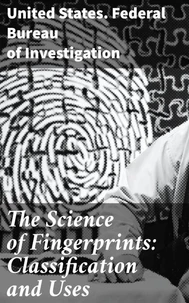The Science of Fingerprints: Classification and Uses
Par :Formats :
Disponible dans votre compte client Decitre ou Furet du Nord dès validation de votre commande. Le format ePub est :
- Compatible avec une lecture sur My Vivlio (smartphone, tablette, ordinateur)
- Compatible avec une lecture sur liseuses Vivlio
- Pour les liseuses autres que Vivlio, vous devez utiliser le logiciel Adobe Digital Edition. Non compatible avec la lecture sur les liseuses Kindle, Remarkable et Sony
 , qui est-ce ?
, qui est-ce ?Notre partenaire de plateforme de lecture numérique où vous retrouverez l'ensemble de vos ebooks gratuitement
Pour en savoir plus sur nos ebooks, consultez notre aide en ligne ici
- Nombre de pages238
- FormatePub
- ISBN859-65--4735614-1
- EAN8596547356141
- Date de parution15/09/2022
- Protection num.Digital Watermarking
- Taille6 Mo
- Infos supplémentairesepub
- ÉditeurDIGICAT
Résumé
In "The Science of Fingerprints: Classification and Uses, " the Federal Bureau of Investigation presents a meticulous exploration of fingerprint analysis, illuminating its significance in forensic science. The book delves into the intricacies of fingerprint classification systems, offering a comprehensive examination of ridge patterns, minutiae points, and their applications in criminal investigations.
Utilizing a methodical and technical literary style, this work serves not only as an essential reference for law enforcement professionals but also as an educational resource for those interested in the intersection of science and criminal justice. The FBI, as an authoritative agency integral to national security and crime prevention, has a rich history of utilizing fingerprinting technology since the early 20th century.
This publication reflects the agency's commitment to advancing forensic techniques and providing rigorously researched standards within the field. By drawing upon years of practical experience and expertise, the FBI offers valuable insights into the evolution and reliability of fingerprint analysis, making it a critical work for understanding modern forensic practices. This book is highly recommended for law enforcement officials, forensic scientists, and criminology students, as it not only deepens understanding of fingerprint methodology but also underscores its role in the broader context of criminal investigations.
Readers seeking a foundational knowledge of fingerprint science will find it an indispensable tool in their professional arsenal.
Utilizing a methodical and technical literary style, this work serves not only as an essential reference for law enforcement professionals but also as an educational resource for those interested in the intersection of science and criminal justice. The FBI, as an authoritative agency integral to national security and crime prevention, has a rich history of utilizing fingerprinting technology since the early 20th century.
This publication reflects the agency's commitment to advancing forensic techniques and providing rigorously researched standards within the field. By drawing upon years of practical experience and expertise, the FBI offers valuable insights into the evolution and reliability of fingerprint analysis, making it a critical work for understanding modern forensic practices. This book is highly recommended for law enforcement officials, forensic scientists, and criminology students, as it not only deepens understanding of fingerprint methodology but also underscores its role in the broader context of criminal investigations.
Readers seeking a foundational knowledge of fingerprint science will find it an indispensable tool in their professional arsenal.
In "The Science of Fingerprints: Classification and Uses, " the Federal Bureau of Investigation presents a meticulous exploration of fingerprint analysis, illuminating its significance in forensic science. The book delves into the intricacies of fingerprint classification systems, offering a comprehensive examination of ridge patterns, minutiae points, and their applications in criminal investigations.
Utilizing a methodical and technical literary style, this work serves not only as an essential reference for law enforcement professionals but also as an educational resource for those interested in the intersection of science and criminal justice. The FBI, as an authoritative agency integral to national security and crime prevention, has a rich history of utilizing fingerprinting technology since the early 20th century.
This publication reflects the agency's commitment to advancing forensic techniques and providing rigorously researched standards within the field. By drawing upon years of practical experience and expertise, the FBI offers valuable insights into the evolution and reliability of fingerprint analysis, making it a critical work for understanding modern forensic practices. This book is highly recommended for law enforcement officials, forensic scientists, and criminology students, as it not only deepens understanding of fingerprint methodology but also underscores its role in the broader context of criminal investigations.
Readers seeking a foundational knowledge of fingerprint science will find it an indispensable tool in their professional arsenal.
Utilizing a methodical and technical literary style, this work serves not only as an essential reference for law enforcement professionals but also as an educational resource for those interested in the intersection of science and criminal justice. The FBI, as an authoritative agency integral to national security and crime prevention, has a rich history of utilizing fingerprinting technology since the early 20th century.
This publication reflects the agency's commitment to advancing forensic techniques and providing rigorously researched standards within the field. By drawing upon years of practical experience and expertise, the FBI offers valuable insights into the evolution and reliability of fingerprint analysis, making it a critical work for understanding modern forensic practices. This book is highly recommended for law enforcement officials, forensic scientists, and criminology students, as it not only deepens understanding of fingerprint methodology but also underscores its role in the broader context of criminal investigations.
Readers seeking a foundational knowledge of fingerprint science will find it an indispensable tool in their professional arsenal.


